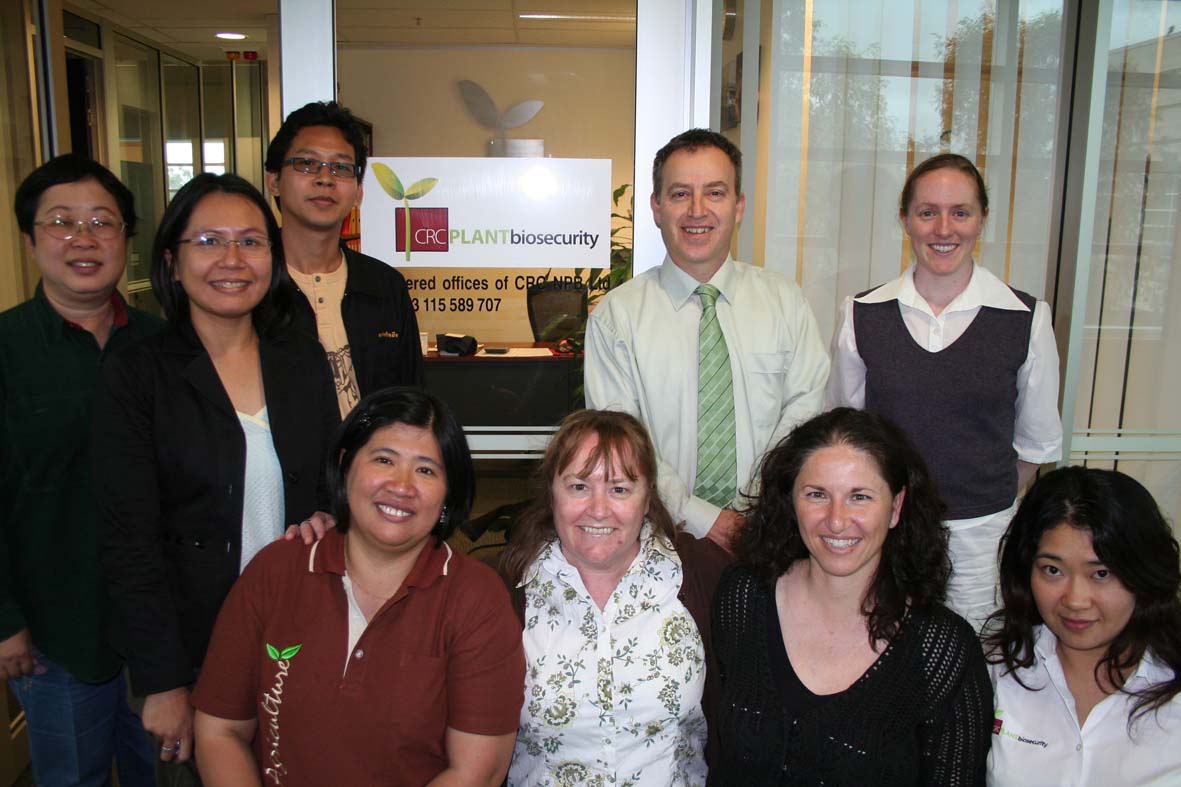Karnal bunt is disease of wheat caused by the fungus Tilletia indica and was first discovered in northern India in 1930.


Plant nematology as a discipline is in a state of depletion in Australia at present, yet nematode pathogens cause losses of at least $450 million per annum in Australia and US$120 billion each year in crop losses worldwide.
There are some serious emergency nematode pathogens, such as the potato cyst-nematodes (Globodera rostochiensis, G. pallida), and stem nematodes (Ditylenchus dipsaci), and their presence is a quarantine issue and a non-tariff barrier to trade. In the past three years several additional species of root-lesion nematode (Pratylenchus spp) have been found in Western Australia (WA). The cereal cyst nematode (Heterodera avenae) is now known to be much more widely spread in WA than previously thought. The root-knot nematode Meloidogyne fallax has recently been detected in WA, and related species such as M. artiellia are serious problems in chickpeas grown in the Mediterranean region where new germplasm is often collected for Australian crop improvement. Climate modelling also indicates that many nematode pests of Mediterranean, sub-tropical and tropical regions would survive well if introduced into Australia.
In order to improve Australian biosecurity against new incursions of nematode pathogens, it is essential to conduct a risk analysis, to assess potential agricultural and horticultural zones at risk.
There is also a need to have improved technologies available to detect, identify and eliminate exotic plant parasitic nematodes. This will enable potential new incursions to be predicted, controlled, and a thorough knowledge of nematode issues will also promote Australian trade and market access through high quality evidence-based support of phytosanitary issues and regulations.
Personnel without nematode knowledge, Australian Quarantine Inspection Services officers and the agricultural industry in general.
The Estonian translation [1] of this page is available here.

Karnal bunt is disease of wheat caused by the fungus Tilletia indica and was first discovered in northern India in 1930.
 Due to the increased movement of people and agricultural
Due to the increased movement of people and agricultural
In late March, the CRC's project team for ‘Increasing diagnostic capacity in Thailand'<
Under the WTO there is increasing pressure on countries to comply with agreed sanitary and phytosanitary standards (SPS) to satisfy trading partners and to access markets. Such SPS conditions apply equally to developed and developing countries, however the latter often lack the expertise, infrastructure and organisational processes required to meet such standards. Together, these elements form the Plant Health System of a country and serve both its trading activities and crop protection needs.
Plant pest diagnostics is at the heart of any Plant Health System and countries that do not have the ability to identify its pests cannot satisfy the requisite SPS conditions for trade. Nor can they protect against the incursions of pests or manage the pests that damage crops. The lack of a Plant Health System is then a huge impediment to economic growth for developing countries.
We designed training activities and implemented a workshop program to improve the capability and capacity of plant pest diagnostics in Thailand. The program focussed on current technologies to provide Thailand with fundamental systems and processes that will provide greater efficiencies in diagnostics and which can be expanded across the Thai Plant Health system. The program focussed on providing molecular identification, traditional taxonomy, digital knowledge systems and remote microscopy which led to the following outcomes.
The current project has provided both skills and lab infrastructure that improve the ability of Thai Post Quarantine PQ to identify and respond to pest threats more efficiently. There is strong support for these new developments from the Thai PQ managers (because of trade implications) and a good prospect that they will continue to develop their expertise and lab infrastructure into the future.
This project was co-ordinated by the Cooperative Research Centre for National Plant Biosecurity in collaboration with its partners, including the CSIRO, Department of Primary Industries and Fisheries Queensland, the Department of Primary Industries Victoria and the NSW Department of Primary Industries.
Thanks also to Dr Ken Walker of the Museum of Victoria who supported training for Thai scientists as well as the development of the Thailand Biosecurity website.
The objective of this project is to produce an inventory of Australian Epiphyas species which, combined with host plant information and reliable identification tools for caterpillars (molecular) and adults (molecular and morphological), will expand our knowledge of the genus, address the concerns of our agricultural trading partners and remove the threat of unjustified quarantine measures.
Epiphyas is a large genus of Australian moths. The light-brown apple moth (Epiphyas postvittana) is a native pest that attacks various horticultural crops. The larvae of Epiphyas caryotis, E. liadelpha, E. pulla and E. xylodes are also known to feed on cultivars in a variety of plant families and are difficult to distinguish from their relative - the light-brown apple moth.
In addition to providing the tools for Epiphyas pest species identification, the revision will inform the management of Australia's biodiversity by providing a sound taxonomic base for all future research involving Australia's indigenous Epiphyas species and their native habitats.
Agricultural Departments, Quarantine Services, Lepidopterists, Ecologists and other managers of Australia's biodiversity and plant biosecurity.

(Left & middle) ~ Brindabella woodland (ACT); Epiphyas caryotis (male).
(Right top & bottom) ~ molecular + morphological identification tools.
The technology comprises ceramic beads (OptoPlexTM beads) on which biomolecular interactions (either DNA or protein-based) are detected, screened, analysed and reported. The technology will be optimised for generic detection devices and, potentially, hand-held devices for use in medical practices, ports and/or farms.
Biosecurity diagnostic protocols currently depend upon a complicated variety of tests based on a wide range of (often expensive) technological platforms. Each platform requires significant investment in single-use equipment and training. Despite this investment, results can be ambiguous and require multiple (and different) tests to produce a confirmed result for a single pest or pathogen. These factors can lead to delayed diagnoses and subsequent delays in responsiveness to biosecurity threats.
The outputs of the project will be used by government/university and industry diagnostic labs and field-based (operational) biosecurity staff such as AQIS/NAQS and state government agencies.

Identification: World-class biosecurity capability for early identification of plant biosecurity threats.
A world-class biosecurity capability for early identification of plant biosecurity incursions in Australia through provision of data, expertise and diagnostic technology that is accurate, sensitive, reliable and cost-effective.
New diagnostic tools to improve responsiveness to plant biosecurity incursion events.
World recognised protocols for rapid identification of harmful pests and diseases are developed and published in international journals.
Databases and new tools to share diagnostic information are standardised.
Protocols for plant biosecurity threats are developed and submitted to the Subcommittee on Plant Health Diagnostic Standards.
Improved diagnostics transferred to end-users to support monitoring and market access activities.
New diagnostic information (services, protocols and expertise) are accessed by end-users via internet systems.
| Title | Leader |
| CRC20004: Karnal Bunt Detection [23] | Dr Mui-Keng Tan [24] |
This project developed an accurate, reliable and internationally recognised DNA-based protocol to detect Karnal bunt. The methodology was validated by laboratories in Australia and overseas and more [23] | |
| CRC20025: Remote Microscopes [25] | Dr John La Salle [26] |
Through a web-based remote microscope system, this project will improve the responsiveness to potential incursions by reducing delays in diagnosis, particularly in remote areas. This technology more [25] | |
| CRC20030: Nanobead Diagnostic Platform [27] | Dr Andrew Geering [19] |
| This project focuses on development of nanosensor technology and software for detection of human, animal and plant pathogens that are highly significant biosecurity threats to public health and more [27] | |
| CRC20054: Plant Bacteria Platforms [28] | Dr Deborah Hailstones [29] |
This project evaluated two of the newer discovery platforms, proteomics and metabolomics, for effectiveness in the identification of functional biomarkers that differentiate closely related more [28] | |
| CRC20055: DNA Databank [30] | Dr Andrew Geering [19] |
The uses of plant disease and insect collections are numerous but most importantly for taxonomic research and comparative biology. From a biosecurity perspective, these collections allow the more [30] | |
| CRC20057: Phosphine Resistance - Proteomics [31] | Peter Campbell [32] |
Phosphine is the main fumigant used in Australia to control insect pests in grain storages; both bulk grain handlers and farmers rely on phosphine for the control of insects and more than 80% of more [31] | |
| CRC20080:Phosphine Resistance - Molecular [33] | Dr David Schlipalius [34] |
This project aimed to provide rapid identification of the phosphine resistance status of any individual R. dominica or T. castaneum collected from grain in storage across more [33] | |
| CRC20081: Biosensor-based Detection of Grain Pests [35] | Dr Alisha Anderson [36] |
There is a need to develop technologies that can be used to rapidly detect and quantify pest infestations in bulk grain to assist in the management of these biosecurity threats. This project more [35] | |
| CRC20093: Increasing diagnostic capacity in Thailand [7] | Dr Gary Kong [9] |
Under the WTO there is increasing pressure on countries to comply with agreed sanitary and phytosanitary standards (SPS) to satisfy trading partners and to access markets. Such SPS conditions more [7] | |
| CRC20115: Resolving the Bactrocera dorsalis Complex [37] | Dr Anthony Clarke [38] |
Flies belonging to the Oriental Fruit Fly species complex, Bactrocera dorsalis, include a number of serious horticultural pest species which are difficult to identify (i.e. B. more [37] | |
| CRC20137: Khapra Beetle Diagnostics [39] | [40] |
This project established a National Reference Laboratory for Dermestidae, with particular reference to the genus Trogoderma. The laboratory provides molecular and morphological diagnostic more [39] | |
| CRC27012: National Diagnostic Database [41] | Dr Gary Kong [9] |
This project is developing a mix of digital technologies designed to provide the building blocks of future diagnostic information systems. The more [41] | |

To undertake research that will provide rapid identification of plant biosecurity threats in order to decrease the cost of eradication and impacts through rapid response.
Links:
[1] http://blog.1800flowers.com/international/taxonomy-nematode-et/
[2] mailto:m.tan@crcplantbiosecurity.com.au
[3] http://legacy.crcplantbiosecurity.com.au/bio/tan
[4] http://legacy.crcplantbiosecurity.com.au/content/diagnosing-karnal-bunt
[5] http://legacy.crcplantbiosecurity.com.au/content/thai-scientists-visit-nations-capital
[6] http://legacy.crcplantbiosecurity.com.au/content/Thailand-training
[7] http://legacy.crcplantbiosecurity.com.au/program/diagnostics/project/crc20093-increasing-diagnostic-capacity-thailand
[8] mailto:Gary.Kong@deedi.qld.gov.au
[9] http://legacy.crcplantbiosecurity.com.au/content/kong
[10] http://legacy.crcplantbiosecurity.com.au/program/diagnostics
[11] http://new.dpi.vic.gov.au/home
[12] http://www.industry.nsw.gov.au/
[13] http://www.dpi.qld.gov.au/cps/rde/dpi/hs.xsl/home_ENA_HTML.htm
[14] http://www.aciar.gov.au/
[15] http://www.doa.go.th/
[16] mailto:Bobbie.Hitchcock@csiro.au
[17] http://legacy.crcplantbiosecurity.com.au/bio/hitchcock
[18] mailto:andrew.geering@deedi.qld.gov.au
[19] http://legacy.crcplantbiosecurity.com.au/content/geering
[20] http://www.csiro.gov.au
[21] http://www.abcrc.org.au/index.aspx
[22] http://www.aibn.uq.edu.au/index.html?page=16744
[23] http://legacy.crcplantbiosecurity.com.au/project/crc20004-karnal-bunt-detection
[24] http://legacy.crcplantbiosecurity.com.au/content/tan
[25] http://legacy.crcplantbiosecurity.com.au/project/crc20025-remote-microscopes
[26] http://legacy.crcplantbiosecurity.com.au/bio/la-salle
[27] http://legacy.crcplantbiosecurity.com.au/project/crc20030-nanobead-diagnostic-platform
[28] http://legacy.crcplantbiosecurity.com.au/program/diagnostics/project/crc20054-plant-bacteria-platforms
[29] http://legacy.crcplantbiosecurity.com.au/content/hailstones
[30] http://legacy.crcplantbiosecurity.com.au/program/diagnostics/project/crc20055-dna-databank
[31] http://legacy.crcplantbiosecurity.com.au/project/crc20057-phosphine-resistance-proteomics
[32] http://legacy.crcplantbiosecurity.com.au/bio/campbellpm
[33] http://legacy.crcplantbiosecurity.com.au/program/diagnostics/project/crc20080phosphine-resistance-molecular
[34] http://legacy.crcplantbiosecurity.com.au/content/schlipalius
[35] http://legacy.crcplantbiosecurity.com.au/program/diagnostics/project/crc20081-biosensor-based-detection-grain-pests
[36] http://legacy.crcplantbiosecurity.com.au/bio/andersona
[37] http://legacy.crcplantbiosecurity.com.au/project/crc20115-resolving-bactrocera-dorsalis-complex
[38] http://legacy.crcplantbiosecurity.com.au/bio/clarke
[39] http://legacy.crcplantbiosecurity.com.au/program/diagnostics/project/crc20137-khapra-beetle-diagnostics
[40] http://legacy.crcplantbiosecurity.com.au/
[41] http://legacy.crcplantbiosecurity.com.au/program/diagnostics/project/crc20012-national-diagnostic-database
[42] mailto:deborah.hailstones@industry.nsw.gov.au
[43] http://legacy.crcplantbiosecurity.com.au/tagcloud/diagnostics
[44] http://legacy.crcplantbiosecurity.com.au/tagcloud/taxonomic
[45] http://legacy.crcplantbiosecurity.com.au/tagcloud/diagnostic
[46] http://legacy.crcplantbiosecurity.com.au/tagcloud/diagnostic+database
[47] http://legacy.crcplantbiosecurity.com.au/tagcloud/fumigation
[48] http://legacy.crcplantbiosecurity.com.au/tagcloud/DNA
[49] http://legacy.crcplantbiosecurity.com.au/tagcloud/CRC20030
[50] http://legacy.crcplantbiosecurity.com.au/tagcloud/black+spot
[51] http://legacy.crcplantbiosecurity.com.au/tagcloud/citrus+canker
[52] http://legacy.crcplantbiosecurity.com.au/tagcloud/fruit+fly
[53] http://legacy.crcplantbiosecurity.com.au/tagcloud/genetics
[54] http://legacy.crcplantbiosecurity.com.au/tagcloud/spectral
[55] http://legacy.crcplantbiosecurity.com.au/tagcloud/training
[56] http://legacy.crcplantbiosecurity.com.au/tagcloud/fumigant
[57] http://legacy.crcplantbiosecurity.com.au/tagcloud/molecular
[58] http://legacy.crcplantbiosecurity.com.au/tagcloud/species+limits
[59] http://legacy.crcplantbiosecurity.com.au/tagcloud/phosphine
[60] http://legacy.crcplantbiosecurity.com.au/tagcloud/padil
[61] http://legacy.crcplantbiosecurity.com.au/tagcloud/Trogoderma
[62] http://legacy.crcplantbiosecurity.com.au/tagcloud/biosensor
[63] http://legacy.crcplantbiosecurity.com.au/tagcloud/grain
[64] http://legacy.crcplantbiosecurity.com.au/tagcloud/pheromones
[65] http://legacy.crcplantbiosecurity.com.au/tagcloud/Receptor
[66] http://legacy.crcplantbiosecurity.com.au/tagcloud/Tribolium
[67] http://legacy.crcplantbiosecurity.com.au/tagcloud/Fruit+flies
[68] http://legacy.crcplantbiosecurity.com.au/tagcloud/bulk+grain+handlers.
[69] http://legacy.crcplantbiosecurity.com.au/tagcloud/molecular+markers
[70] http://legacy.crcplantbiosecurity.com.au/tagcloud/biomarkers
[71] http://legacy.crcplantbiosecurity.com.au/tagcloud/test
[72] http://legacy.crcplantbiosecurity.com.au/tagcloud/CRC20004
[73] http://legacy.crcplantbiosecurity.com.au/tagcloud/diagnostic+protocol
[74] http://legacy.crcplantbiosecurity.com.au/tagcloud/karnal+bunt
[75] http://legacy.crcplantbiosecurity.com.au/tagcloud/quarantine
[76] http://legacy.crcplantbiosecurity.com.au/tagcloud/spore+germination
[77] http://legacy.crcplantbiosecurity.com.au/tagcloud/Tilletia+indica
[78] http://legacy.crcplantbiosecurity.com.au/tagcloud/plant
[79] http://legacy.crcplantbiosecurity.com.au/tagcloud/microscopes
[80] http://legacy.crcplantbiosecurity.com.au/tagcloud/CRC20025
[81] http://legacy.crcplantbiosecurity.com.au/tagcloud/diagnostic+protocols
[82] http://legacy.crcplantbiosecurity.com.au/tagcloud/metabolomics
[83] http://legacy.crcplantbiosecurity.com.au/tagcloud/pathogen
[84] http://legacy.crcplantbiosecurity.com.au/tagcloud/proteomics
[85] http://legacy.crcplantbiosecurity.com.au/tagcloud/epp
[86] http://legacy.crcplantbiosecurity.com.au/tagcloud/gps
[87] http://legacy.crcplantbiosecurity.com.au/tagcloud/assays
[88] http://legacy.crcplantbiosecurity.com.au/tagcloud/biomolecular+interactions
[89] http://legacy.crcplantbiosecurity.com.au/tagcloud/ceramic+beads
[90] http://legacy.crcplantbiosecurity.com.au/tagcloud/research